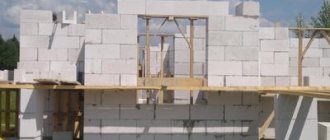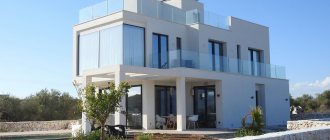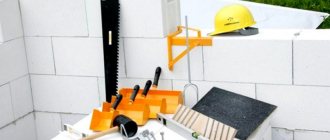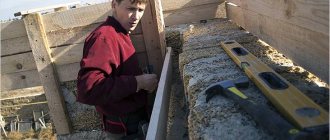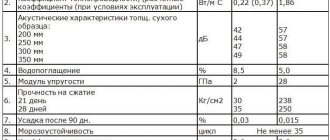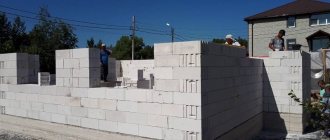Beton-House.com
Website about concrete: construction, characteristics, design. We combine the experience of professionals and private craftsmen in one place
Gas block production
Aerated concrete is one of the most popular materials. Most often it is used in the form of blocks for the purpose of erecting walls.
Many, probably, were interested: how does the process of manufacturing such products take place in a factory and what factors have a direct impact on the final result? This is what we will talk about in this article.
So, the production of autoclaved aerated concrete: what is the technology?
- Required set of equipment and materials
- Production stages
What is aerated concrete
Aerated concrete is a type of cellular concrete, which is characterized by the presence of pores, which are obtained as a result of a chemical reaction of quicklime and a gas-forming agent, most often aluminum powder. The composition of the material, as well as the production method, endows the product with a special set of properties and qualities, which we will first consider.
Brief characteristics of the material
Aerated concrete is characterized by the following quality indicators:
- Thermal conductivity is one of the main advantages of products. The coefficient varies from 0.09 to 0.38. However, it is worth considering that such numerical indicators are typical for blocks in a dry state. With operational humidity of products, it can increase significantly.
- Strength and density. The density grade, in accordance with GOST, can be from 300 to 1200.
Note! Blocks with a density of 500 are used most often. This value is quite sufficient for the construction of a building several floors high. At the same time, thermal conductivity will remain at the proper level.
- Frost resistance. Aerated concrete is distinguished in this regard by an indicator enviable for many materials. Some manufacturers claim that their products can withstand up to 100, and sometimes up to 150 freezing and thawing cycles.
- Shrinkage. This is typical for aerated concrete. The indicator is 0.3 mm/m2. Often cracks appear on the walls as a result.
- Water absorption is the main disadvantage of the material. Aerated concrete can absorb up to 25% moisture, so products need protection from its harmful effects.
- Thickness of the masonry layer. Recommended – from 0.4 meters. However, in practice, if you go into the nuances, much more will come out. When calculating this thickness, manufacturers do not take into account cold bridges and other factors contributing to heat loss.
- Soundproofing. In general, aerated concrete is able to isolate a room from extraneous noise, and it will be quite comfortable to be in it.
- Vapor permeability. Coefficient – 0.2. Thanks to this ability, the most comfortable microclimate will be established in the room, since aerated concrete tends to absorb excess moisture and release it when the air is excessively dry.
Technical characteristics of gas blocks
Since we have looked at the main characteristics, it’s time to figure out what types of aerated concrete there are and how they differ from each other.
Types of products
Classification of aerated concrete in accordance with GOST 21520-89:
| Name of the classification, its basis | Types of aerated concrete | Comments |
| Depending on density and scope of application | Thermal insulation | It has a density of 300-400. It is used as a material for insulation, since it cannot withstand any significant loads. It has a low thermal conductivity coefficient - from 0.09 in a dry state. |
| Structural and thermal insulation | The most popular. It is characterized by a density of 500 to 900, which is sufficient for the construction of a private house. Used in the construction of walls and partitions. | |
| Structural | The most durable of the types. Density varies between 1000-1200. Able to withstand significant loads. It is used in the construction of buildings up to 12-15 meters high. | |
| According to curing method | Autoclave (synthetic hardening) | It differs from its non-autoclave competitor in that at the last stage of manufacturing, the products are processed using special machines. An autoclave for the production of aerated concrete acts on products using high pressure and temperature. |
| Non-autoclave (hydration hardening) | Achieves technical strength naturally. In many respects it is inferior to synthetic hardening aerated concrete. | |
| Depending on geometric deviations | Blocks of the first category of accuracy | They are distinguished by the smallest geometric deviations: up to 1.5 in size, up to 2 mm diagonally. Laying is done using glue. |
| Blocks of the second category of accuracy | They are characterized by more significant deviations: up to 2 mm in size, up to 4 mm in diagonal. Corners are allowed to be broken up to 5 mm. Blocks can be laid using either glue or mortar. | |
| Blocks of the third category of accuracy | For such products, GOST sets the following maximum deviations: up to 5 mm – in size, up to 6 mm – diagonally, chips at corners – up to 1 cm.
| |
| By type of silica component | On the sand | The most commonly used is quartz sand. |
| On the ashes | ||
| On other secondary industrial products | ||
| Depending on the type of binder | On cement binder | Cement content is at least 50% of the total amount. |
| On Ash | The content of highly basic ash is at least 50%. | |
| On mixed | Consists of cement, lime and slag | |
| On the slag | Slag content – not less than 50% | |
| On lime binder | Cement content – no less than 15%, lime – no less than 50%. | |
| By purpose | Wall blocks | As the name suggests, wall ones are used for the construction of walls, partition walls are used for partitions. U-shaped ones are used when creating stationary formwork, when forming lintels, and so on. |
| Septal | ||
| U-shaped |
Main results
Non-autoclaved aerated concrete is a fairly popular material in the construction industry. However, according to some indicators, it is significantly inferior to synthetically hardened aerated concrete. First of all, this consists in a lower level of frost resistance, strength and increased shrinkage ability.
The production of these products does not cause significant difficulties. But when making at home, the release process requires special care and, to some extent, experience. Since failure to implement the technology and incorrect dosing of components can lead to negative consequences, primarily in relation to product characteristics and properties.
Autoclaved and non-autoclaved aerated concrete have some differences. This is due to the different hardening method and composition of the components. Having analyzed the main properties of these types of block, it is difficult to disagree with the recommendations of experts who advise giving preference to autoclave products.
Manufacturing Process Overview
The production of autoclaved aerated concrete can occur exclusively in factory conditions. Let's look at it step by step and start with a list of necessary equipment and materials.
Required set of equipment and materials
Equipment for autoclaved aerated concrete can be purchased in several types:
- A landline line is the most budget option. You can select the equipment yourself, but you should take into account the fact that the output volume, production speed and the final result will depend on this.
The standard set includes: a mold for blocks, a cutting apparatus, a component dispenser, an aerated concrete mixer, a gas generator and, of course, an autoclave.
- Conveyor line. The most expensive. The entire process takes place in the most automated mode, the participation of workers is minimal, only requiring the presence of several operators who will control the operation of the machines.
The equipment is distinguished by its high capabilities for producing large batches of products per day and production speed. The products are also of the highest quality with almost perfect geometry.
The conveyor-type autoclaved aerated concrete production line consists of:
- Mixer;
- Component dispenser;
- Rail track for automatic movement;
- Belt conveyor;
- Mixer;
- Form block;
- Heat treatment chambers;
- Installations for cutting block solids;
- Autoclave.
Now it’s time to sort out the necessary materials.
Autoclave production of aerated concrete requires the availability of the following raw materials:
- Quartz sand;
- The water is clean;
- Cement grade not lower than M 400;
- Quicklime;
- Aluminum powder or paste;
- Additives to accelerate hardening and improve qualities and properties.
Molding
From the mixer, the raw materials enter large-volume molds. Here the mixture is kept for several hours at a temperature of approximately 50º C. The reaction takes place and the mass rises, resembling yeast dough. A huge number of cells (pores) appear, which give the building material its name. After the mass has acquired the required volume, some more time is needed for it to pre-harden. Next, it is turned 90º and placed in a vertical position on the autoclave tray. Here the mass remains during cutting, autoclaving and separation.
At the end of the process, the mixture is fed to the cutting section.
Comparison of autoclaved and non-autoclaved aerated concrete
Since we have already understood the production technology, let’s compare factory-made autoclave and home-made products.
Comparison of synthetic and hydration-hardening aerated concrete:
| Property names, characteristics | Comments |
| Thermal conductivity | Both types of aerated concrete have a low thermal conductivity coefficient, however, if we compare its ratio with the strength and density of the block, the autoclave is significantly ahead of hydration-hardening aerated concrete. The thickness of the wall, while maintaining the same parameters, is different. For an autoclave it is from 40 cm, for a non-autoclave it is from 65 cm. |
| Strength | The autoclave block is more durable and resistant to mechanical stress. |
| Frost resistance | And in this indicator, the synthetic hardening gas block is ahead. It is characterized by up to 150 freezing and thawing cycles, while its competitor can only boast of 35-50 cycles. |
| Shrinkage | Non-autoclaved aerated concrete is more susceptible to shrinkage, the value reaches 0.6 mm/m2. |
| Appearance | Autoclaved aerated concrete – white. And non-autoclave is gray. |
| Durability | Synthetic hardening blocks, according to manufacturers, are characterized by a durability of 200 years, and a non-autoclave - 50 years. |
| Ease of production | Both types of aerated concrete are not difficult to produce. However, the autoclave unit is manufactured using automated installations, which significantly speeds up the process and virtually eliminates labor costs. The advantage of the hydration hardening block, in this case, is only that. That you can make it yourself and, at the same time, you will need instructions, some raw materials and budget equipment. |
| Application in construction | Both products are used in construction, but synthetic hardening gas block is more popular due to its superior performance. |
| Price | Non-autoclaved aerated concrete is somewhat cheaper. If you try your hand at production yourself, you can save a lot. |
| Geometry | Since the autoclave block is manufactured using machines, its geometry is, in most cases, much better. |
As you can see, the palm definitely belongs to autoclaved aerated concrete.
Areas of use
Autoclaved aerated concrete is widely used in the construction of industrial buildings, residential and commercial real estate. External walls are erected from autoclaved aerated blocks, which can be single-layer, combined or double-layer. Such internal walls are designed to take on the load of the upper floors.
It is important to lay the first row perfectly straight.
Autoclave blocks can form partitions and walls of fireproof rooms, as well as fill steel or concrete frames. A separate area of use is the formation of floor slabs (density of autoclaved aerated concrete 800-1000 kg/m3) in buildings. Material with a lower density (slabs) is used for thermal insulation of basements, attics, etc.
Autoclaved aerated concrete has been used in the production of wall panels for residential, public and industrial buildings. This applies to strip-cut reinforced panels. For typical projects of large-panel buildings, such panels consist of several standard sections.
Return to contents
Advantages and disadvantages of products
Now let's look at the main advantages of products made by autoclave hardening:
- The blocks are lightweight, which will significantly reduce the load on the base of the building.
- The products are large in size, which will undoubtedly significantly speed up the building construction process.
- As we have already found out, the material is environmentally friendly.
- Aerated concrete does not burn and does not interact with fire.
- The products have enviable frost resistance, density and strength, which will allow the construction of a durable structure with high performance characteristics.
- The low coefficient of thermal conductivity helps to maintain heat in the room during the cold season and coolness on hot days of summer. This will also help reduce home heating costs.
- The low price of the material is a significant plus.
- The technology for producing autoclaved aerated concrete is not complicated. You don't have to acquire any special skills. Everything happens automatically, under operator control of the process.
Advantages of gas blocks
The disadvantages are as follows:
- Aerated concrete is characterized by hygroscopicity, that is, the ability to absorb moisture and, moreover, in large quantities. Therefore, the material must be protected from its harmful effects. Otherwise, crystallizing, it can begin to destroy the structure of the block from the inside, causing irreparable damage to the products.
- Various elements are poorly attached to aerated concrete. It is necessary to use specialized hardware. And if you want to secure especially heavy objects, the fixation units need to be planned in advance at the project level.
- Shrinkage of the material is another significant drawback. Cracks often form on the surface of the blocks.
- Fragility of products. Aerated concrete is not resistant to mechanical stress, this is especially evident during transportation and during work.
Compound
Aerated concrete gets its amazing properties thanks to: limestone, Portland cement, calcium silicate, aluminum pastes (suspensions), calcium chlorides, water, etc., which are included in its composition in a strictly defined percentage ratio with each other (to form products with specified density characteristics etc.). The components are calculated in kilograms to obtain 1 m3 of the finished mixture. The binder can be lime, cement, slag, gypsum, either alone or in various mixtures. The most common base is cement with parts of lime. Additional additives make it possible to produce blocks of different colors and give the product specific properties.
Return to contents
Calculation of profitability of production
Now, let's find out whether the production of autoclaved aerated concrete is cost-effective.
It is worth considering some factors:
- Economic feasibility and financial benefits depend on the region, purchasing power, and set price. And also: the costs of organizing production and the speed of sale of finished products. Therefore, the calculation will be very approximate and is for informational purposes only.
- Also note that raw materials can be purchased at completely different prices. The final cost of production depends largely on its value.
- It is important to attract the required number of employees; the costs associated with wages can be quite significant.
Now let's look at the table.
Approximate calculation of the profitability of the production of autoclaved aerated concrete using a conveyor-type line:
| Name of costs/income | Unit cost, rubles | Total cost |
| Complete set of machines | About 8,500,000 | 8500000 |
| Raw material consumption for the production of 1 cubic block: cement, sand, emulsion, plasticizer, other additives) | 1800 | 1800 |
| Costs of raw materials based on the production of 3000 cubic meters of products per month | 5400000 | 5400000 |
| Payroll per month | 300000 | 300000 |
| Costs for electricity, water supply, business expenses of the enterprise | 1400000 | 1400000 |
| Sales income, subject to the sale of 3000 cubic meters of products per month | 3500 | 10500000 |
| Advertising expenses | 500000 | 500000 |
| Renting a warehouse, premises for production | 550000 | 550000 |
| Total monthly income minus all expenses except the cost of equipment | — | 2350000 |
| The approximate time it takes for a business to pay off | 3.6-4 months |
Autoclaving
The cut blocks are placed in an autoclave - a chamber with a temperature of 180-190ºC, a pressure of about 12 bar and saturated steam. Here the future building material is aged for 12 hours. During this time, a crystalline structure is formed in the blocks, which distinguishes autoclaved aerated concrete from other materials and gives it decent practical properties.
After processing in an autoclave, the finished building material is laid out to cool using a divider tap.
Reviews
Knowing the difference between autoclave and natural hardening materials makes it easier to make a choice. Developers noted the following features of autoclaved aerated concrete:
- Ease of processing is present when building a house with arched internal partitions. A regular hand saw was used to cut the openings on site, without fraying the edges and the work did not take much time. The disadvantage is the need for reinforcement.
- There are no problems during laying and cutting. A regular cord is used to control the level. Due to improper storage, the blocks got wet even from light rain, but regained their weight after 4 days. It is very important to prepare the site correctly.
- Living in a house made of aerated concrete blocks with a wall thickness of 600 mm is quite cozy and comfortable. It is very warm, which reduces space heating costs. There is no need for external insulation.
- High price of materials and delivery. But the costs are offset by the speed of construction, a small amount of masonry mortar and the lack of additional thermal insulation.
Even a few reviews make it clear that it is better to use autoclave blocks that have improved characteristics.
